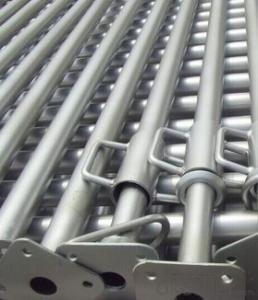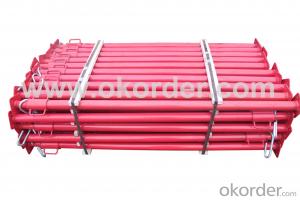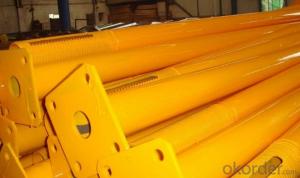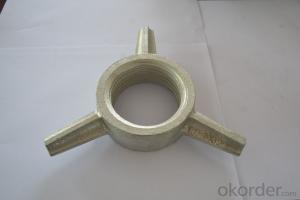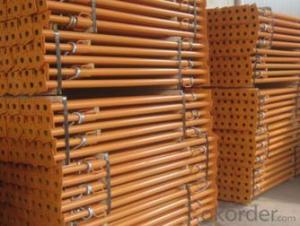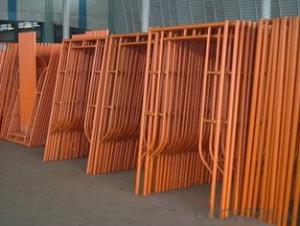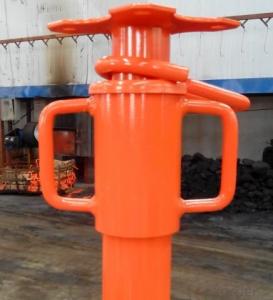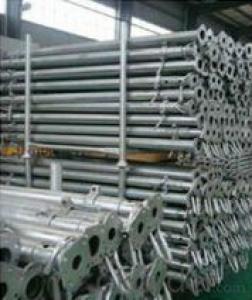Scaffolding And Steel Prop
- Loading Port:
- China Main Port
- Payment Terms:
- TT OR LC
- Min Order Qty:
- -
- Supply Capability:
- -
OKorder Service Pledge
Quality Product, Order Online Tracking, Timely Delivery
OKorder Financial Service
Credit Rating, Credit Services, Credit Purchasing
You Might Also Like
Quick Details
| Type: | Scaffolding Part Type: |
| Usage: | Main Material: | Surface Finish: | |||
| Length: | German Type OD: | Italian Type OD: | |||
| Spanish Type OD: | Regular Thickness: | Popular Color: |
Packaging & Delivery
| Delivery Detail: | 20~25days after receiving your deposit or L/C |
Specifications
1.alibaba China manufacturers Scaffolding Steel Prop
2.original manufacturer,
3.Certificate:BV
4.OEM service
| Regular Specification & Measurement | ||||
| Description | Length | External Tube | Inner Tube | Weight |
| Spanish Props | 0.8-1.4m | 48*1.6*600mm | 40*1.6*800mm | 4.86kg |
| 1.6-3.0m | 48*1.6*1400mm | 40*1.6*1600mm | 7.54kg | |
| 2.0-3.5m | 48*1.8*1500mm | 40*1.8*2000mm | 9.02kg | |
| 2.2-4.0m | 48*2.0*1800mm | 40*2.0*2200mm | 10.76kg | |
| Italian Props | 1.6-2.9m | 56*1.6*1300mm | 48*1.6*1600mm | 8.27kg |
| 1.8-3.1m | 56*1.8*1300mm | 48*1.8*1800mm | 9.37kg | |
| 2.0-3.6m | 56*2.0*1600mm | 48*2.0*2000mm | 11.35kg | |
| 2.2-4.0m | 56*2.2*1800mm | 48*2.2*2200mm | 13.27kg | |
| German Props | 1.6-2.7m | 60*2.0*1100mm | 48*2.0*1600mm | 9.23kg |
| 2.0-3.5m | 60*2.5*1500mm | 48*2.5*2000mm | 13.38kg | |
| 2.2-4.0m | 60*3.0*1800mm | 48*3.0*2200mm | 17.36kg | |
| 3.0-5.5m | 60*3.2*2500mm | 48*3.2*3000mm | 24.26kg | |
| The length and thickness also could cater to customer orders. | ||||
- Q:How do you prevent theft of steel props from construction sites?
- Preventing theft of steel props from construction sites requires implementing a combination of security measures and proactive strategies. Here are some effective methods to help prevent theft: 1. Secure the perimeter: Install fencing around the construction site to create a physical barrier and limit unauthorized access. Ensure that the fencing is sturdy and difficult to climb or cut through. 2. Access control: Control access to the site by implementing a system that requires identification or access cards for entry. This will help track who enters and exits the construction site, making it easier to identify potential thieves. 3. Lighting and surveillance: Install bright and adequate lighting throughout the construction site to deter thieves from attempting theft. Additionally, set up surveillance cameras at strategic locations to monitor the site around the clock. Ensure that the cameras are visible to act as a deterrent. 4. Security personnel: Hire security guards to patrol the construction site regularly. Their presence will discourage thieves and provide an immediate response to any suspicious activity. 5. Marking and tracking: Use visible markings on the steel props, such as unique identification numbers or specific paint colors, to make them easily identifiable. This discourages theft and makes stolen items more challenging to sell. Additionally, consider using GPS tracking devices on high-value steel props to aid in recovery if theft occurs. 6. Secure storage: Store steel props securely in a locked and well-organized storage area when not in use. This reduces the visibility and accessibility of the props, making them less appealing to potential thieves. 7. Employee awareness and training: Educate construction site workers about the importance of theft prevention and the impact it has on the project. Encourage them to report any suspicious activity and provide training on how to secure valuable equipment properly. 8. Regular inventory checks: Conduct regular inventory checks to ensure that all steel props are accounted for. This helps identify missing items promptly and increases the chances of recovery. 9. Collaboration with local law enforcement: Establish a relationship with local law enforcement agencies and inform them about the construction project. This can lead to increased patrols and faster response times in case of theft. 10. Community engagement: Engage with the local community, such as neighboring businesses and residents, and ask them to report any suspicious activity they observe near the construction site. Building strong relationships with the community can help create a network of vigilant eyes on the site. By implementing these preventive measures and being proactive in safeguarding steel props, construction sites can significantly reduce the risk of theft and protect valuable assets.
- Q:Can steel props be used for supporting temporary signage or billboards in windy areas?
- In areas with high wind, steel props are a suitable choice for supporting temporary signage or billboards. Renowned for their strength and stability, steel props are perfectly equipped to endure powerful gusts. They furnish a secure and dependable support structure capable of resisting the force exerted by the wind on the signage or billboard. Moreover, steel props offer effortless adaptability and reinforcement, guaranteeing stability and safety for the temporary signage or billboard even in blustery conditions.
- Q:Can steel props be used in residential tower construction?
- Residential tower construction can utilize steel props, also referred to as steel shores or steel props. These temporary supports are adjustable and serve to provide vertical support to beams, slabs, and walls. They are commonly employed in various construction projects, including residential tower construction. There are several reasons why steel props are preferred in residential tower construction. Firstly, they are constructed with high-quality steel that offers exceptional strength and durability. This is critical in supporting the weight and load of the residential tower throughout the construction process. Steel props possess the capability to handle heavy loads, making them suitable for high-rise structures. Secondly, steel props are adjustable, allowing for effortless installation and customization. They can be easily extended or retracted to fit the required height, providing flexible support as the construction progresses. This adaptability ensures that the props can accommodate changes in the construction process, including different floor heights and load requirements. Furthermore, steel props are relatively lightweight compared to other support systems. This feature contributes to their ease of handling and transport on construction sites, reducing labor and installation time. Their lightweight nature also renders them suitable for temporary support during construction, as they can be effortlessly relocated and repositioned as needed. Another advantage of utilizing steel props in residential tower construction is their cost-effectiveness. Steel props are relatively inexpensive when compared to other support systems, making them an appealing option for construction projects with budget constraints. Additionally, their reusability adds to their cost-effectiveness, as they can be utilized in multiple projects over time. In conclusion, steel props are a suitable and commonly employed support system in residential tower construction. Their strength, adjustability, lightweight nature, and cost-effectiveness make them an ideal choice for providing temporary support during the construction of residential towers.
- Q:Can steel props be used for supporting temporary stages or podiums?
- Steel props are a versatile option for providing support to temporary stages or podiums. These props are commonly employed in construction to bear heavy loads and offer temporary structural reinforcement. Their adjustable height feature allows for various applications, including supporting temporary stages or podiums. With a substantial load-bearing capacity, steel props guarantee stability and safety. Their easy installation and removal make them a practical choice for temporary structures. Moreover, steel props can be customized to different heights, catering to the specific requirements of the stage or podium. All in all, steel props prove to be a dependable and efficient solution when it comes to supporting temporary stages or podiums.
- Q:How do steel props prevent structural collapse during construction?
- During construction, steel props, also referred to as adjustable steel props or acrow props, play a vital role in averting structural collapse. These temporary supports are extensively utilized in the construction industry to reinforce structures and maintain stability at different stages of the building process. One of the primary functions of steel props is to evenly distribute the weight load of the structure to the ground. In construction sites, load-bearing walls or columns are often removed or modified, which can compromise the overall stability of the structure. To prevent collapse, steel props are strategically positioned beneath the areas where load-bearing elements have been altered, providing temporary support. Furthermore, steel props possess adjustable height capabilities, allowing construction workers to customize the support based on specific project requirements. This adjustability is crucial as it ensures the stability of the structure as construction progresses through various stages. It also enables workers to compensate for uneven or sloping surfaces, providing a level foundation for the load-bearing elements. Another advantage of steel props is their durability and capacity to bear heavy loads. Typically constructed from high-quality steel, they exhibit strength and resilience. These props can effectively support numerous structures, including beams, slabs, walls, and ceilings, ensuring their stability throughout the construction process. Moreover, steel props are designed with ease of installation and dismantling in mind, making them convenient and time-efficient for construction projects. Their versatility and flexibility enable construction workers to swiftly adjust and relocate the props as needed, accommodating changing load requirements and construction sequences. In conclusion, steel props are indispensable in preventing structural collapse during construction by offering temporary support, evenly distributing weight loads, and compensating for the removal or modification of load-bearing elements. Their adjustability, durability, and ease of installation establish them as vital tools in ensuring the stability and safety of structures throughout the construction process.
- Q:Can steel props be used for supporting temporary roofing structures in snowy regions?
- Yes, steel props can be used for supporting temporary roofing structures in snowy regions. Steel is a durable and strong material that can withstand the weight of snow on the roof. It provides stability and structural support to the temporary roofing structure, ensuring that it can withstand the heavy snow loads common in snowy regions. Additionally, steel props are adjustable and can be easily set at the desired height, allowing for proper alignment and support of the roof. However, it is important to consider the design and engineering requirements specific to the region and the temporary roofing structure to ensure that the steel props are appropriately sized and positioned for optimal support and safety.
- Q:What are the common sizes of steel props?
- The sizes of steel props used in construction projects can vary depending on specific requirements. However, the industry commonly utilizes standard sizes. Typically, the most frequently used steel props range in length from 1.8 meters (6 feet) to 5.5 meters (18 feet). These props have adjustable heights to accommodate diverse support needs. Regarding outer diameter, steel props are typically available in two primary sizes: 48-50mm (1.9-2 inches) and 60-63mm (2.4-2.5 inches). The choice of outer diameter depends on the necessary load-bearing capacity for a given application. It is important to recognize that these sizes are merely general guidelines. Actual steel prop sizes may differ depending on the manufacturer and the project's specific requirements. Seeking guidance from a structural engineer or construction professional is advised to determine the appropriate size of steel props for a particular construction project.
- Q:How do you store and transport steel props?
- To store and transport steel props, it is important to follow proper procedures to ensure their safety and prevent any damage. Firstly, steel props should be stored in a dry and well-ventilated area to avoid rust or corrosion. They should be kept away from any moisture or dampness that could potentially compromise their structural integrity. When it comes to transporting steel props, it is advisable to use a suitable vehicle or container that can securely hold and protect them during the journey. The props should be securely fastened and stacked in a way that minimizes movement and prevents any potential damage. It is crucial to avoid overloading the transportation vehicle to prevent any accidents or injuries. Furthermore, it is recommended to use protective coverings such as plastic or tarpaulin to shield the steel props from dust, dirt, and external elements that could potentially cause damage. Adequate padding should be used between the props and other materials to prevent any scratching or impact during transportation. Regular inspections should be conducted to check the condition of the steel props before and after transportation. Any signs of damage or deformity should be addressed immediately to prevent any accidents or structural failures during use. Overall, proper storage and transportation of steel props require careful handling, suitable equipment, and adherence to safety guidelines. By following these procedures, the integrity of the steel props can be maintained, ensuring their longevity and safe usage.
- Q:Do steel props comply with building codes and regulations?
- Yes, steel props do comply with building codes and regulations. Steel props, also known as steel support systems or adjustable steel props, are widely used in the construction industry to provide temporary support during construction or renovation processes. These props are designed and manufactured in accordance with the relevant building codes and regulations to ensure their structural integrity and safety. Building codes and regulations vary from country to country, but they generally provide guidelines on various aspects of construction, including structural stability, load-bearing capacity, fire safety, and occupational health and safety. Steel props are designed to meet these requirements and undergo rigorous testing and certification processes to ensure their compliance. Steel props are typically made from high-quality steel with the necessary strength and durability to support heavy loads. They are adjustable in height, allowing them to be tailored to specific construction needs. In addition, they often come with safety features such as locking pins or clips to prevent accidental collapse. Before using steel props on a construction site, it is essential to consult the local building codes and regulations to ensure compliance. Building inspectors and authorities may conduct inspections to verify that the steel props meet the required standards. By using steel props that comply with building codes and regulations, construction projects can proceed with confidence in their structural integrity and adherence to safety standards.
- Q:How do you prevent rust on steel props?
- To prevent rust on steel props, there are several preventive measures you can take: 1. Apply a protective coating: One effective way to prevent rust on steel props is by applying a protective coating. This can be done by using a high-quality paint or primer specifically designed for use on metal surfaces. Make sure to clean and dry the props thoroughly before applying the coating to ensure proper adherence. 2. Use galvanized or stainless steel props: Galvanized or stainless steel props have a higher resistance to rust compared to regular steel. Galvanization involves applying a layer of zinc to the steel, which acts as a protective barrier against rust. Stainless steel, on the other hand, contains chromium that forms a passive oxide layer, preventing corrosion. 3. Keep the props dry: Moisture is a common catalyst for rust formation. Ensure that the steel props are kept dry and avoid exposing them to excessive humidity or water. If the props come into contact with water, promptly dry them to prevent rust from forming. 4. Regular cleaning and maintenance: Regularly clean the steel props to remove any dirt, debris, or other contaminants that may promote rust formation. Use a mild detergent or a metal cleaning solution and a soft brush or cloth to clean the props thoroughly. After cleaning, dry them completely before storing or using them. 5. Store the props properly: When not in use, store the steel props in a dry and well-ventilated area. Avoid storing them in damp or humid environments as this can accelerate rust formation. Additionally, consider using moisture-absorbing products like silica gel or desiccants in the storage area to reduce humidity levels. 6. Inspect for damage: Regularly inspect the steel props for any signs of damage, such as scratches, dents, or chipping of the protective coating. Promptly repair or replace any damaged props to prevent rust from spreading. By following these preventive measures, you can significantly reduce the risk of rust formation on steel props, ensuring their longevity and functionality.
1. Manufacturer Overview |
|
|---|---|
| Location | |
| Year Established | |
| Annual Output Value | |
| Main Markets | |
| Company Certifications | |
2. Manufacturer Certificates |
|
|---|---|
| a) Certification Name | |
| Range | |
| Reference | |
| Validity Period | |
3. Manufacturer Capability |
|
|---|---|
| a)Trade Capacity | |
| Nearest Port | |
| Export Percentage | |
| No.of Employees in Trade Department | |
| Language Spoken: | |
| b)Factory Information | |
| Factory Size: | |
| No. of Production Lines | |
| Contract Manufacturing | |
| Product Price Range | |
Send your message to us
Scaffolding And Steel Prop
- Loading Port:
- China Main Port
- Payment Terms:
- TT OR LC
- Min Order Qty:
- -
- Supply Capability:
- -
OKorder Service Pledge
Quality Product, Order Online Tracking, Timely Delivery
OKorder Financial Service
Credit Rating, Credit Services, Credit Purchasing
Similar products
New products
Hot products
Related keywords
